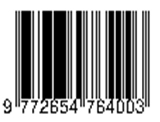PEMERIKSAAN KOMPOSISI GLASS FIBER KOMERSIAL DENGAN TEKNIK X-RAY FLUORESCENCE SPECTROMETER (XRF)
Abstract
Glass fiber lebih sering digunakan daripada polyethylene fiber sebagai komponen FRC dalam dunia kedokteran gigi. Glass fiber dental di Indonesia tersedia dalam jumlah terbatas dan memiliki harga yang relatif mahal. Tujuan dari penelitian ini adalah untuk memeriksa komposisi dari E-glass fiber dental dan glass fiber non dental menggunakan teknik XRF sehingga dapat ditentukan tipe dari masing-masing glass fiber non dental. Sampel terdiri dari 10 g E-glass fiber dental, 10 g fiberglass mats, 10 g fiberglass roving dan 10 g woven roving. Masing-masing sampel dihaluskan, selanjutnya dianalisa dengan dengan menggunakan X-Ray Fluorescence Spectrometer (XRF). Hasil analisa XRF sampel menunjukkan kandungan oksida terbesar pada E-glass fiber dental adalah SiO2 (45,47%), CaO (38,49%) dan Al2O3 (12,11%). Kandungan oksida terbesar pada fiberglass mats adalah SiO2 (56,88%), CaO (16,24%) dan Na2O (12,91%) demikian pula dengan woven roving yaitu SiO2 (55,86%), CaO (18,71%) dan Na2O (11,80%). Sedangkan fiberglass roving menunjukkan kandungan oksida terbesar antara lain SiO2 (52,56%), ZrO2 (14,64%) dan CaO (10,03%). Hal tersebut menunjukkan bahwa komposisi kandungan oksida pada sampel memiliki kemiripan dengan persentase yang berbeda. Berdasarkan pada analisis XRF disimpulkan bahwa glass fiber non dental jenis fiberglass mats dan woven roving mengarah ke tipe C-glass dan fiberglass roving mengarah ke tipe AR-glass.
Keywords
Full Text:
PDFReferences
Tuloglu N, Bayrak S, Tunc ES. Different clinical applications of bondable reinforcement ribbond in pediatric dentistry. Eur J of Dent. 2009; 9 : 329-333.
Juloski J, Beloica M, Goracci C, Chieffi N, Giovannetti A, Vichi A, Vulicevic ZR, Ferrari M. Shear bond strength to enamel and flexural strength of different fiber-reinforced composites. J Adhes Dent. 2012; 14(10) : 1-8.
Mohan S, Gurtu A, Singhal A, Guha C. Fibre reinforced composite- a review and case report. J of Dent Sci & Oral Rehab. 2012; 45-47.
Abdulmajeed AA, Narhi TO, Vallitu PK, dan Lassila LV. The effect of high fiber fraction on some mechanical properties of unidirectional glass fiber-reinforced composite. J Dent Mat. 2011; 27 : 313-321.
Khan AS, Azam MT, Khan M, Mian SA, Rehman IU. An update on glass fiber dental restorative composite : a systematic review. Mat Sci & Eng C. 2014; 47 : 26-39.
Agrawal M, Practicioner P, Vadodara. Application of ultra high molecular weight polyethylene fibres in dentistry : a review article. J of Adv Med & Dent Sci Res. 2014; 2(2) : 95-98.
Zhang M, Matinlinna, JP. E-glass fiber reinforced composites in dental applications. Silicon. 2012; 1-5.
Karaman A, Kir N, Belli S. Four application of reinforced polyethylene fiber material in orthodontic practice, AJO-DO, 2002; 121: 650-654.
Alla RK, Sajjan S, Alluri VR, Ginjupalli K, Upadhya N. Influence of fiber reinforcement on the properties of denture base resins. J of Biomat & Nanobiotech. 2013; 4 : 91-97.
Zhu D, Wang Y, Zhang X, Cheng S. Interfacial bond property of uhmwpe composite. Polym. Bull. 2010; 65 : 35-44.
Scibante A, Sfondrini, MF, Broggini S, D’Alloco M, Gandini P. Clinical Study Efficacy Of Esthetic Retainers : Clinical Comparison Between Multi stranded Wires and Direct-Bond Glass Fiber-Reinforced Composite Splints, Int J of Dent. 2011; 1-5.
Raszewski Z, Nowakowska D. Mechanical properties of hot curing acrylic resin after reinforced with different kinds of fibers. Int. J. of Biomed Mat Res. 2013; 1(1) : 9-13.
AGY. High strength glass fiber. http://www.agy.com/wpcontent/uploads/2014/03/High_Strength_Glass_Fibers-Technical.pdf. 2014. diunduh pada 21 Februari 2015
Wallenberger FT, Watson JC, Hong Li. Glass fibers. ASM Int. 2001; 21: 27-30.
Kinsella M, Murray D, Crane D, Mancinelli J, Kranjc M. Mechanical properties of polimeric composites reinforced with high strength glass fiber, http://www.agy.com.2014. diunduh pada 17 Oktober 2014.
Vallitu PK. Glass fiber in fiber-reinforced composites dalam Matinlinna JP. Handbook of Oral Biomaterials. Singapore : Pan Stanford publishing. 2014; 255-270.
Yamasaki T. XRF major element analyses of silicate rocks using 1:10 dilution ratio glass bead and a synthetically extended calibration curve method. Bul of the Geo Surv of Jap. 2014; 65(7/8) : 97-103.
Omatola KM, Onojah AD. Elemental analysis of rice husk ash using x-ray fluorescence technique. Int Jof Phy Sci. 2009; 4(4) : 189-193.
Phillips, K., X-Ray Fluorescence Spectroscopy (XRF) Fast And Precise Inorganic Solid Analysis. http://www.innovationservices.philips.com/sites/default/files/materials-analysis-xrf.pdf diunduh pada17 Februari 2015.
Munasir, Triwikantoro, Zainuri M, Darminto. Uji XRD dan XRF pada bahan meneral (batuan dan pasir) sebagai sumber material cerdas (CaCO3 dan SiO2), JPFA, 2012; 2(1): 20-9.
Fabricio AR, Renato QCJ, Fabiola LPP, Helcio RNJF, Carvalho RF, Mutlu O. Evaluation of bond strength between glass fiber and resin composite using different protocols for dental splinting, Eur J of Gen Dent. 2013; 2(3): 281-285.
Schall K, Fiberglass dalam Kogel JE, Trivedi N, Barker JM, Krukowski ST, Industrial minerals & rock-commodities, markets and uses. 7thed. Society for mining, metallurgy and exploration Inc. 2006; 1369-1374.
Karlsson S, Jonson B. The technology of chemical glass strengthening-a review. Eur J Glass Sci Tech A. 2010; 51 (2) : 41-54.
Mallick PK. Fiber reinforced composites. Materials, manufacturing and desain. 3th ed. Franc: CRC Press. 2008.
Wallenberger FT, Bingham PA. Fiberglass and Glass Technology. Energy-Friendly Composition and Application. New York : Springer-Verlag. 2010; 45
DOI: https://doi.org/10.33854/JBDjbd.30
DOI (PDF): https://doi.org/10.33854/jbd.v1i2.30.g19
Refbacks
- There are currently no refbacks.
Copyright (c) 2014 B-Dent, Jurnal Kedokteran Gigi Universitas Baiturrahmah




